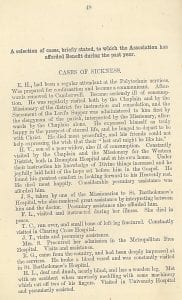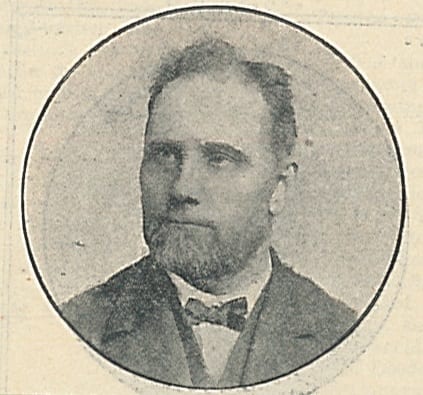Two contrasting lives – John P. Gloyn (1830-1907) and Henry S. Lomas (1829-1905)
By H Dominic W Stiles, on 18 November 2016
John Pugh Gloyn (1830-1907) was a fortunate man. He was born in Clapham, London on the 16th of May 1830, son of C.J. Gloyn, a Launceston born solicitor (British Deaf-Mute, 1895). He lost lost his hearing in his third year as a result of an inflammation “following the careless application of a cold knifeblade to a bruise” (BDT, 1904, p.109).
He was educated at the Old Kent Road Asylum under Dr. Buxton, when Stainer was assistant master, where he learnt sign language, the main method of teaching at that time (ibid). On leaving school he worked as a telegraphist, then set up in business as a mathematical instrument maker (ibid).
Henry Samuel Lomas (1829-1905?) was in contrast an unfortunate man. He was born in 1829 in St. Pancras, London, son of Samuel, a wheelwright from Sussex, and his wife Hannah, from Derbyshire. He lived in Somers town, the notorious slum area partly destroyed by the building of St. Pancras station in 1868. He also attended the Old Kent Road Asylum. I noticed the following advertisement in A Magazine Intended Chiefly for the Deaf and Dumb for July 1874 inside the back cover.
Lomas was born deaf, and had very poor vision – sometimes he is called blind but there are degrees of blindness of course, and he must have had sufficient vision to be a ‘boot maker’ in both the 1901 census and on the records of St. Pancras Workhouse in Streatham. I do not know when or how he lost his leg. The Association for the Deaf and Dumb annual reports note several instances in the years around 1870 when a deaf person was knocked over and injured by a vehicle, so perhaps that happened. 
 From the Trustees Committee minutes, for the meeting on 2nd May 1873, p. 205 we see that they gave Henry a small gratuity, tough clearly not enough in view of the appeal above.*
From the Trustees Committee minutes, for the meeting on 2nd May 1873, p. 205 we see that they gave Henry a small gratuity, tough clearly not enough in view of the appeal above.*
On the left is a page of cases from the Annual Report 1869-70 for the Association for the Deaf and Dumb (later R.A.D.D. now R.A.D.) which explains all too briefly that he lost his two fingers “unwisely meddling with some machinery”. If he was in the University Hospital (UCLH), I wonder if there are any surviving records of their patients for that period in the London Metropolitan Archives.
In the 1851 and 1861 censuses Gloyn was living at 14 Brunswick Place, near Old Street, with his widowed father and various siblings. In 1848-9 he began to involved in ‘deaf work’ in a voluntary capacity, at first with Matthew Burns, who held services near Gloyn’s home in Shaftesbury Hall, Aldersgate, with the London Society for the Propagation of the Gospel in Aid of the Deaf and Dumb. From January 1867 he conducted services in St. Paul’s Schools, Deptford, at the invitation of the Rev. Mr. Turner (Our Notice Board, 1907, BDT p.110). In May 1872 he was appointed Missionary for the Northern District of the Association for the Deaf and Dumb, and he gave up his other work (BDM, 1895). Gloyn’s obituary says,
Among the deaf he was a shining example of bright cheerfulness, and was never afraid to say what he thought, and had the very highest reputation as an upright man of unfailing punctuality and promptness in business matters. His penny bank had for many years the largest amount of deposits, showing how well he drilled the deaf of north London in ways of thrift.
Lomas was a real survivor. He started off poor, spent his life poor and disadvantaged, and ended it poor – yet despite all his misfortune he survived, we think, until early 1905 (search FREE DMB), though that would require a death certificate to confirm. Gloyn died on the 19th of May, 1907. Although they lived near one another, I wonder how much contact they had after they left school? Perhaps Gloyn visited Lomas as part of his mission work, and maybe he brought his case to the attention of the Association.
 Photo of Gloyn from BDM, 1895.
Photo of Gloyn from BDM, 1895.
Many thanks to Norma McGilp of @DeafHeritageUK and John Lyon* @BristolDolt for additional information.
References
Association for the Deaf and Dumb annual reports – various issues.
A Magazine Intended Chiefly for the Deaf and Dumb
GLOYN
Census 1851 – Class: HO107; Piece: 1499; Folio: 446; Page: 14; GSU roll: 87832
Census 1861 – Class: RG 9; Piece: 129; Folio: 6; Page: 5; GSU roll: 542578
Popular deaf-mutes – J.P. Gloyn. British Deaf-Mute, 1895, 4(39), 34. (photo)
Our Missions Today; Mr John P. Gloyn & Islington, BDT 1904 p.109
John Pugh Gloyn, Our Notice Board, No.19, 1907, p.6
LOMAS
1851 Class: HO107; Piece: 1496; Folio: 854; Page: 36; GSU roll: 87828-87829
1861 Class: RG 9; Piece: 103; Folio: 95; Page: 43; GSU roll: 542574
1871 Class: RG10; Piece: 211; Folio: 85; Page: 88; GSU roll: 824596 (Drapers Place)
1901 Class: RG13; Piece: 480; Folio: 96; Page: 18
 Close
Close

